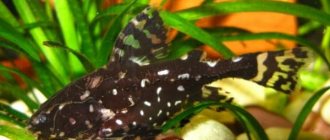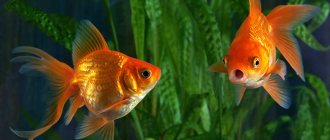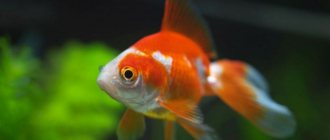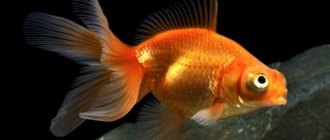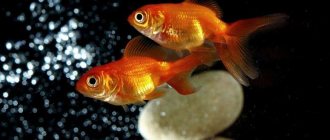Goldfish today have many fans in aquariums around the world, and their popularity continues to grow. When you go to a pet store, you will probably be amazed at how beautiful, funny and cute some of them can be. But is it worth buying any breed you like if you are a beginner aquarist? This article will help you figure out which varieties of goldfish can be successfully kept even by beginners, and which ones will require a little more experience and knowledge.
10 Goldfish Breeds for Beginners and Experienced Aquarists
According to one version, we owe the appearance of fancy goldfish to Buddhist monks. Out of mercy, they preserved the offspring of carp with birth defects. Later, on the basis of these surviving fish, amazing breeds were developed.
Common goldfish
You don't know what an aquarium goldfish looks like? When you see this breed, you will not be mistaken if you think that this is it. Such fish usually have a bright orange or yellow (various shades) color with a characteristic metallic sheen. Thanks to this appearance, such a fish can really easily be called “golden”.
Common goldfish. © aqvium
However, there are ordinary goldfish of other colors, for example, white. Distinctive feature: flat elongated body, relatively hard rounded fins and a short, slightly forked tail. This goldfish is the easiest to find for sale. Due to their availability and low cost, they are sometimes even purchased as food for reptiles and predator fish.
Perhaps, in comparison with its more bizarre and original counterparts, many aquarists will find the ordinary goldfish rustic. However, do not rush to pass by it, because its unassuming appearance is balanced by ease of care. This species is ideal for beginners, since these fish are closest to their “great-grandfathers” - silver crucian carp.
Advantages of an ordinary goldfish:
- inexpensive cost;
- often on sale;
- unpretentious to living conditions (temperature changes, poor water quality, etc.).
Disadvantages of the Common Goldfish:
- over time it grows up to 30 centimeters long;
- a large aquarium is required;
- ordinary appearance.
Goldfish "Comet"
This variety was developed in the USA. Such fish are often kept in garden ponds together with or instead of the famous ornamental Koi carp. Outwardly, they resemble an ordinary goldfish, but their body has more elongated proportions. The Comet's tail can be almost equal to the length of its body (hence the name - due to its resemblance to a comet with a long trail).
Goldfish "Comet". © MalchauDK
In addition, Comet goldfish also have noticeably longer fins than regular goldfish, and the tail fin has characteristic pointed tips.
These are very nimble “sports” fish that can move at high speed. The most common species are orange-red or bicolor (red and white). But such fish can also have pure white, chocolate and yellow colors.
Advantages of the Comet goldfish:
- increased endurance;
- Possibility of use in garden ponds.
Disadvantages of Comet goldfish:
- requires a large aquarium volume (at least 180 liters of water per adult);
- outwardly resembles an ordinary carp.
Maintenance and care
To keep goldfish, certain conditions are needed. They require a large aquarium equipped with all the necessary equipment, clean water and balanced food. Otherwise, pets will look bad, get sick and die prematurely.
A big advantage in breeding is the indifference to lighting indicators. It is enough to set ordinary aquarium lamps to 6,000–6,500 K (Kelvin). But their main purpose will be to highlight the beauty of the fish and give effect to the decor.
Aquarium
The recommended container volume is 80 liters. The water requirement per individual is 40–50 liters. Preference is given to classic rectangular aquariums with a height of up to 50 cm.
Features of aquarium arrangement:
- Bottom coating. Coarse sand or large rounded pebbles are placed on the bottom so that fish cannot swallow it. Fine sand is undesirable. It does not hold plant roots well (fish will dig up algae) and creates turbidity.
- Filtration. Goldfish love to burrow in the soil, picking up dirt from the bottom. Their “home” needs to be thoroughly cleaned. A filter is installed for this purpose. Recommended capacity - 3 l/h.
- Aeration. A prerequisite is the saturation of water with oxygen through continuous movement of the liquid. If there are a lot of plants in the aquarium, there is good lighting and an additional supply of carbon dioxide, the aerator is turned on only at night.
- Plants. They perform several functions at once: they release nitrogen, serve as a substrate for bacteria and provide vitamin supplements for fish. Preference is given to algae with hard leaves and a strong root system - Echinodorus, Cryptocoryne, Aponogeton. Artificial plants will come in handy. They will serve as decoration and create additional comfort for the fish.
Special attention should be paid to cleaning the aquarium. This includes weekly washing of the filter sponge and siphoning of the substrate.
Siphoning is the name for cleaning the soil using a special device - a siphon (aquarium vacuum cleaner). The essence of the process is to suck out small particles - detritus (dead organic matter) from the surface and from the thickness of the filler. It is important to act carefully so as not to mix the layers.
A water change is required. The replacement liquid is pre-settled for a day. The aquarium is filled to the top, leaving a few centimeters. Please note that plants and decorations will also take up space.
Water environment
One of the main conditions for a long and prosperous life of goldfish is the use of high-quality water. Its parameters must comply with certain standards.
Requirements:
- temperature - + 20... + 25°C;
- acidity - 6.9–7.2;
- hardness - no less than 8.
The temperature regime depends on membership in a specific group. Long-bodied breeds require less warm water than short-bodied breeds.
The water in the aquarium is changed partially every week, completely - once a year.
You will need:
- bucket;
- 1.5–2 m of hose;
- ladle;
- siphon with “pear”;
- scraper;
- brush.
How to change the water in an aquarium:
- Remove and wash the decorative elements with saline/soda and wipe with a brush. Rinse in water drained from the aquarium.
- Use a scraper to wipe off the deposits from the walls of the aquarium.
- Remove rotting/dead algae. Thin out the rest.
- Siphon the substrate while pumping out water. If necessary, pump out the remaining volume with a hose.
- Add clean water in small portions.
You can also learn about the features of keeping goldfish in the following video:
Compatibility
It is best to keep goldfish in a separate aquarium. It is not recommended to mix long-bodied and short-bodied representatives - they have different behavior and temperament (more active individuals damage the fins of slow-moving subspecies).
If you really want to combine different aquarium pets, you should give preference to calm and not small fish. You should not place golden tenants with barbs. Fast comets freely coexist with medium-sized cichlids.
Goldfish "Shubunkin"
The Shubunkin fish is mainly distinguished from the ordinary goldfish and the Comet by its characteristic spotted multi-colored color. This fish was bred in China. In the original, its name sounds “syubunkin” and is translated as “brocade”.
The Shubunkin fish is mainly distinguished from the ordinary goldfish and the Comet by its spotted multi-colored color. © rwtate
Shubunkin fish are dotted with numerous multi-colored spots with the obligatory presence of black. A good representative of the breed should have a lot of blue in combination with white, as well as red and black tones. In fact, the bright spots that you see on the body of calico goldfish are on the skin under transparent scales. And only some of the scales are not transparent and have a metallic sheen.
Often, outbred goldfish of variegated color, obtained as a result of free crossing, also appear on sale under the name “Shubunkin”. The real “Shubunkin” has a slender, long body and lacks the “potbelliness” characteristic of other breeds.
There are three main types of the Shubunkin breed:
- "American Shubunkin", a distinctive feature is a long, deeply notched caudal fin;
- The "Shubunkin Bristol" is known for its very large, wide, slightly forked tail with round "B" shaped lobes;
- The London Shubunkin has a shorter tail than other breeds and a rounded tail.
The Shubunkin goldfish is a large fish and reaches a length of 36 centimeters as an adult.
Advantages of the Shubunkin goldfish:
- bright appearance;
- ease of care.
Disadvantages of the Shubunkin breed:
- requires large volumes of water.
Goldfish "Riukin"
A variety of egg-shaped goldfish with a characteristic curve that begins just behind the head, resembling a hump. Moreover, the more pronounced the hunchback, the more valuable a particular specimen is considered to be a representative of the breed.
"Riukin" has a characteristic hump, pointed nose and calico coloration. © Lyudmila Svetlitskaya
"Riukins" have a swollen, shortened body and a rather long caudal fin (but shorter than that of the veiltail). “Riukin” fish have a characteristic pointed “muzzle” and expressive eyes. This is the only breed of goldfish whose body is taller than its length.
The characteristic color of “Riukina” is calico, that is, there are chaotically scattered spots of white, orange and blue-blue in combination with black dots. The presence of blue makes the fish more attractive and valuable.
Riukin goldfish are not as hardy as the regular goldfish, but they are more resilient than many fancy breeds. The maximum size of the fish as an adult is usually no more than 20 centimeters.
Advantages of the Riukin goldfish:
- perfect as a first goldfish for beginners;
- tolerate temperature fluctuations;
- do not grow too large.
Disadvantages of the Riukin breed:
- due to their characteristic body shape, they will need more vertical space than long-bodied goldfish;
- more aggressive and temperamental compared to other fancy goldfish;
- “shortness” leads to a tendency to constipation and pathologies of the swim bladder.
Reproduction
Breeding certain varieties of goldfish at home is an impossible task for beginning aquarists, but it is still possible to obtain offspring from some species. Fish reach sexual maturity at the age of one year, but they are allowed to mate only after reaching 3 years. Spawning usually occurs in the spring - during this period, males develop white growths on their gills and pectoral fins, and females become plump and pleasantly rounded.
For reproduction, one male and two females are placed in the spawning tank, having previously arranged the container: live plants should be planted and an aerator installed. Spawning lasts about 6 hours, after which the parents are placed in an old tank.
The fry from the eggs appear after 3-6 days, and after a day you need to start taking care of the babies by choosing the right diet for them. Many experienced aquarists prefer to feed the fry with special food for small goldfish, which can be purchased at pet stores.
Goldfish are one of the most famous aquarium inhabitants, many people became familiar with them through children's fairy tales and books. For a long time, these golden beauties were considered unpretentious and hardy creatures that did not require special care, which led to the rapid death of these wonderful fish. To avoid such mistakes, you should take care of a capacious species tank and high-quality feeding for goldfish, and then golden pets will delight their owner for decades.
Goldfish "Oranda"
A popular goldfish prized for its bizarre growths on its head. By the way, if the “cap” has grown too much and prevents the fish from seeing, then it can be trimmed, since the growth does not have nerve endings.
“Little Red Riding Hood” is the most popular “Oranda”. © Lyudmila Svetlitskaya
The most famous and beloved variety of the breed is the “Little Red Riding Hood” fish with a characteristic red growth that stands out against the background of a pure white body. Another characteristic color is a bright orange body and a black stripe on the upper part of the body. But in fact, the color of the “Oranda” is represented by almost all the colors of the rainbow.
The body is oval, slightly oblong. The tail can be ribbon, veil or fan-shaped. "Orandas" are distinguished by a very calm character, they are always friendly to their neighbors. In this regard, the breed is considered the kindest of all types of goldfish. However, the Oranda is the largest of all the fancy breeds, as its size can reach more than 30 centimeters.
Oranda varieties such as “Tigerhead” and “Lionhead” also have a similar appearance to “Little Red Riding Hood”. They differ from the first one mainly in the shape and location of the growth.
Advantages of the Oranda breed:
- playful but calm disposition;
- relative unpretentiousness.
Disadvantages of the Oranda breed:
- the head growth can be affected by fungal diseases;
- very large size as an adult.
Compatibility
Finding suitable neighbors with whom goldfish get along in an aquarium is a difficult task, since these charming creatures demonstrate compatibility only with their relatives. At the same time, it is not recommended to keep individuals with different body lengths together, since they differ not only in size, but also in temperament.
Having settled goldfish with other representatives of the underwater kingdom, you should be prepared for inevitable injuries to the eyes, fins and scales of golden beauties. Large and aggressive species will attack goldfish, while small and peaceful fish will become dinner for goldfish. In any case, proximity to other species will negatively affect the life expectancy of goldfish.
Goldfish "Veiltail"
The same goldfish from Pushkin’s fairy tale with a luxurious long tail has the appearance of a classic veil tail. Their fins are so long that they can even stretch along the bottom of the aquarium. According to the breed standard, their tail should be at least twice as long as their body and completely separated from the beginning to the very tip. Such a luxurious tail fin elegantly trails behind the fish like a train.
The luxurious tail fin elegantly trails behind the Veiltail goldfish like a train. © um-yesplease-photography
The fin blades have a characteristic rectangular shape. Adding additional attractiveness is the very high dorsal fin, reminiscent of a boat sail (ideally it should be as high as the body, without bending to the side). The body of veil-tailed goldfish has a compact ovoid shape.
“Veil tails” require special attention, since their rich fins can not only be easily damaged by the decoration of the aquarium, but are also actively pinched off by their fellows. By nature, these fish are balanced and leisurely, and many owners describe the veiltail as a “good-natured and gentle” fish. In adulthood, it reaches 20 centimeters in length, not counting the tail.
Advantages of the Veiltail breed:
- fabulous appearance;
- calm disposition.
Disadvantages of the Veiltail breed:
- swims slowly, has difficulty competing for food;
- the caudal fin is easily damaged;
- prone to fungal and parasitic infections.
Tendency to diseases
With proper care, fish rarely get sick. Signs that your pet is sick or experiencing discomfort:
- refusal to eat;
- protruding scales;
- drooping dorsal fin;
- various rashes on the body (ulcers, dark spots, plaque);
- swollen abdomen;
- unnaturally bulging eyes;
- strange behavior (the fish stands motionless, with its head buried in the ground or wall of the aquarium, lies on the bottom, leaning on its side, or swims near the surface, quickly swallowing air);
- When moving, it turns over onto its back.
If your pet has one or more suspicious signs of deterioration in its condition, immediate measures must be taken to treat it.
Goldfish "Telescope"
Telescope goldfish are known for their huge bulging eyes, which can be round, conical, cylindrical, etc. Breeders believe that the value of a fish is determined precisely by the size of its unusual eyes - the larger they are, the more valuable the specimen. Moreover, although the eyes of telescopes are impressive in size, they do not have the best vision. Telescopes have a harder time competing for food with goldfish, which have a conventional eye arrangement.
The most commonly found “Telescope” on sale is black. © Lyudmila Svetlitskaya
The most common color is solid black (another name for the dark variety “Black Moor”). Also interesting is the two-tone black and white “Panda” color. Variegated “calico” and bright orange “golden telescopes” are also often found.
The breed and the shape of the tail differ. It can be either small or veiled. A particular type of telescope is called a “butterfly”, as their wide forked tail actually resembles the wings of butterflies. In terms of size, telescopes usually do not grow more than 20-25 centimeters.
Advantages of the Telescope breed:
- unusual appearance, “velvet” scales;
- relatively hardy.
Disadvantages of the Telescope breed:
- clumsiness;
- vision problems;
- may easily damage the eye.
Goldfish "Water Eyes"
A very controversial goldfish. Her appearance can seem either “ugly” and repulsive, or exotically attractive. “Water eyes” come in all colors - from solid colors (solid black, white, bright orange, yellow) to multi-colored calico. The most popular are the black ones.
The main distinguishing feature of the “Water Eyes” goldfish is two huge transparent bubbles near the eyes, filled with liquid. © tengyi
The main distinguishing feature of the breed is two huge transparent bubbles near the eyes, filled with liquid - lymph. Such cheek pouches begin to grow in fry from 6-9 months and continue to develop until the age of two. Of course, it is not so easy for these fish to manage such “bags”, but they are no less active than their counterparts. They should not be completely isolated from goldfish of other breeds, however, their neighbors should be the least aggressive.
If the eye bags are damaged, the blisters may recover over time, but do not reach their previous size. “Water eyes” are one of the smallest fancy goldfish, reaching a length of no more than 12 centimeters in adulthood.
Advantages of the Water Eyes breed:
- exotic appearance that leaves no one indifferent;
- very loved by children;
- small size.
Disadvantages of the Water Eyes breed:
- clumsy, uncompetitive;
- require increased attention;
- eye vesicles are susceptible to injury and eye infections.
Goldfish "Pearl"
This fish is very easy to recognize by its round belly and unique scales. It consists of rows of small, tough scales that resemble beads and cover most of its body. The characteristic “pearls” are actually composed of calcium carbonate deposits. However, on very large adult fish they can become quite large.
The Pearl goldfish is very easy to recognize by its round belly and unique scales. © mSafdel
Necklaces on the scales give the fish a fantastic look and attract everyone's attention to the representatives of the breed. The "beads" on the scales develop with age and may be absent in young specimens.
Pearl fish come in many colors, including calico (the most common), orange, white, blue-black, two-tone, and even chocolate. Their body is rounder and potbellied compared to other breeds of goldfish, which is why pearls are also called “balls”. This breed is distinguished by a good-natured, peaceful character. The size of an adult is about 20 centimeters.
Advantages of the Zhemchuzhinka breed:
unique, one-of-a-kind scales.
Disadvantages of the Zhemchuzhinka breed:
- growths can be knocked off by sharp objects in the aquarium, especially if the fish begin to scratch their sides (if the ammonia level in the water exceeds);
- a bloated stomach interferes with full swimming;
- susceptible to problems with the intestines and swim bladder.
The right diet
Oranda can eat both plant and live or artificial food. Because she needs a lot of carbohydrates, she needs certain foods. Foods with natural additives support and improve bright color options.
Aquarium pets are fed:
- bloodworm;
- tubifex;
- daphnia;
- salad;
- spinach;
- live or frozen worms.
Asians are quite gluttonous, so it is important to ensure that they do not overeat. Adults are fed once a day, and fry - 2 times. Dry food should be given in small portions so that the fish eat it without any leftovers. In some orandas, fleshy growths can make it difficult to see food, so they are fed longer.
Fish eat spinach
To prevent the fish from eating ornamental plants, its diet must be enriched with greens. You can avoid excessive pollution in the aquarium with the help of high-quality flakes, after which the inhabitant of the artificial reservoir creates less waste. With special food, you don’t have to worry about your fish becoming infected with diseases or infections.
If an aquatic pet overeats, after eating it swims on its side. The fish will return to normal if you put it on a diet for 1-2 days.
